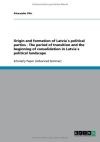
Origin and formation of Latvia's political parties - The period of transition and the beginning of consolidation in Latvia`s political landscape
Buch, Englisch, 28 Seiten, GRIN Verlag
Autor: Alexander Pilic
Erscheinungsdatum: 2000
ISBN: 3638757323
Aufrufe gesamt: 1386, letzte 30 Tage: 1
Scholarly Paper (Advanced Seminar) aus dem Jahr 2000 im Fachbereich Politik - Int. Politik - Region: Osteuropa, Note: 1,5 (A), Freie Universität Berlin (Otto Suhr Institute), 13 Eintragungen im Literaturverzeichnis, Sprache: Englisch,
Abstract:
However, the Popular Front was not the only political movement during the period of Latvia¿s national rebirth in the early 1990s. Besides former members of the Soviet elites, which did not participate in the LTF, there also existed a conservative-nationalist wing of the opposition which called itself Latvian National Independence Movement (LNNK). These three groups made up the main sources which fed and still feed Latvian parties with personalities and political beliefs up to this present day. Since the first party foundations ten years ago, Latvia saw many of them being born but almost the same number of parties disappearing again.
Some of them were very popular during one election, but in the next one they could not collect enough votes to get into parliament. Some parties collapsed after a short period of time, others split into new movements or merged with other parties. The party-system¿s instability seems to have effects on the Latvian political landscape as a whole. Although the Republic of Latvia is far from being chaotic or unreliable no coalition-government lasted for the whole parliamentary term and in each of the three elections during the nineties more than one half of the participating parties took part for the first time. On the other hand, especially during the last two years some small parties merged into larger ones or at least formed joined factions in parliament and lists in the elections, like the Social-Democrats, the conservative Fatherland and Freedom Union or the socialist Harmony for Latvia party. This development could be considered as a step towards larger and more significant parties which would lead to more stability within Latvia¿s political landscape.
In order to find out whether there is a tendency for consolidation among political parties I will concentrate this essay in first place on their process of formation since the beginning of Latvia¿s democratization in the late eighties. Furthermore, I will link the parties¿ genesis with their roles in parliament and administration to explain their significance for Latvian politics. In my conclusion I will summarize the collected data in order to give an answer to the examined issue.
Fachthemen
Publikationen: 7
Aufrufe seit 11/2007: 2842
Aufrufe letzte 30 Tage: 2



